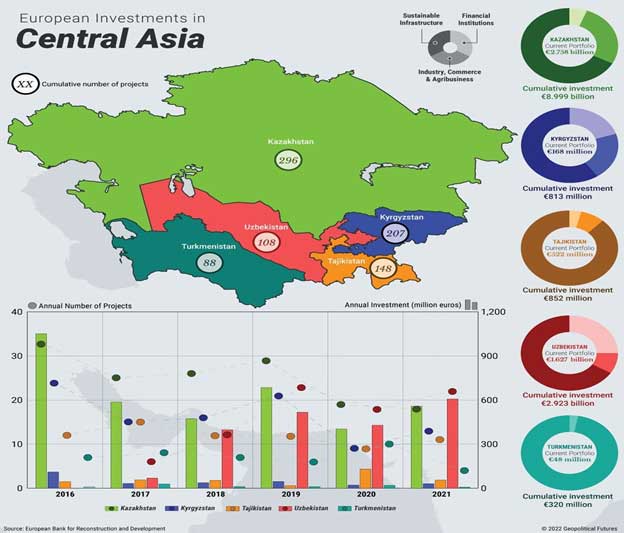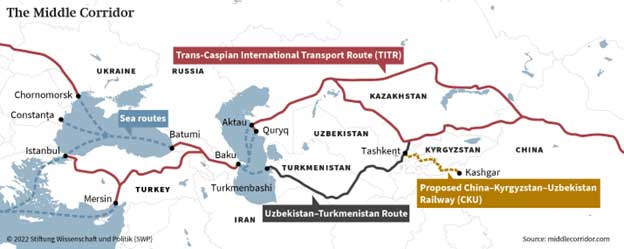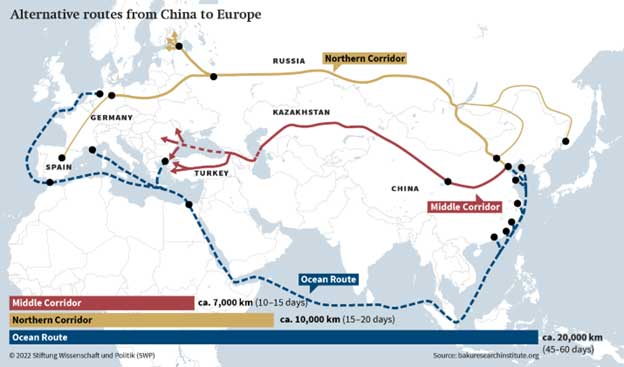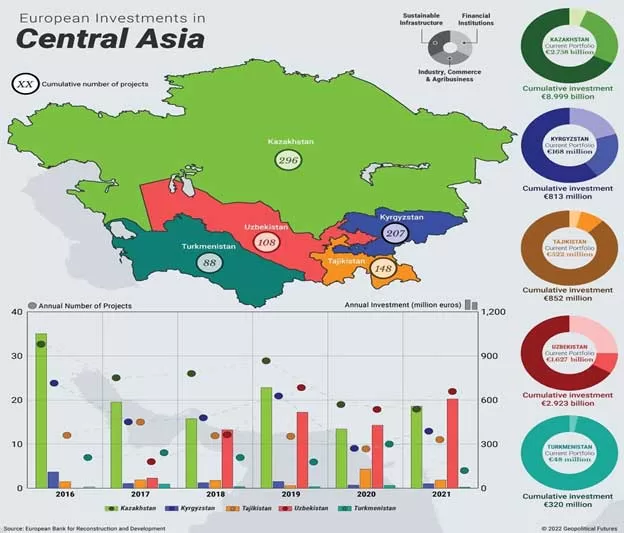

Collaboration with Central Asian nations in developing sustainable energy sources not only contributes to global efforts against climate change but also ensures energy security. Furthermore, due to its strategic location, the region plays a crucial role in global security and stability. Engaging with Central Asia enables the West to address challenges like counterterrorism, drug trafficking, and environmental issues.
Central Asia, abundant in natural resources, presents an appealing opportunity for Western economies aiming to broaden their supply chains. Kazakh companies already produce a significant portion of these materials crucial for the EU economy, including titanium, beryllium, tantalum, and niobium. French President Emmanuel Macron’s visit to Kazakhstan in November 2023 resulted in substantial deals for France to procure these vital minerals and metals, emphasizing their strategic importance beyond mere economic value.
Central Asia, recognizing the strategic value of connectivity, is actively working to enhance regional integration and infrastructure development. By fostering closer economic and diplomatic ties among neighboring countries, Central Asia seeks to unlock its potential as a hub for trade, investment, and cultural exchange, driving sustainable growth and prosperity. Enhanced connectivity underscores Europe’s assertive stance in Central Asia, amplifying its presence and influence across the region. Through improved transportation networks, digital infrastructure, and diplomatic ties, Europe aims to forge deeper relationships and capitalize on the economic and geopolitical significance of Central Asia’s diverse landscapes and resource-rich territories.
| Key Routes and Infrastructure in Eurasia’s Trade Network | |
| Route/Corridor | Description |
| Middle Corridor | A trade route spanning the Central Asian steppe, the Caspian Sea, and the Caucasus Mountains, connecting China and East Asia with Georgia, Turkey, and Europe. Also known as the China-Central Asia-West Asia Corridor. Major components include the Trans-Caspian East-West-Middle Corridor Initiative, the Trans-Caspian International Transport Route, and the Trans-Caucasus Trade and Transit Corridor. |
| Northern Corridor | Includes the New Eurasian Land Bridge and the Trans-Siberian Land Bridge through Russia, requiring nineteen days to traverse. |
| Traditional Maritime Route | Passes through the Indian Ocean, taking twenty-two to thirty-seven days for transit. |
| International North-South Transport Corridor | Provides access to the Persian Gulf and Indian Ocean. |
| Bolashak-Chelyabinsk railway line | Kazakh section to be modernized, facilitating expanded connections and trade opportunities. |
| Kuryk Port | Targeted for development into a full-fledged logistics center similar to Aktau, aiming to enhance maritime capabilities. |
| Aktau | Plans to create a container hub, expanding Kazakhstan’s maritime capabilities. |
| Dostyk-Moiynty railway line | Expansion planned to strengthen ties with neighboring countries like China and Uzbekistan. |
| Bakhty-Ayagoz and Darbaza-Maktaaral | New railway sections are intended to enhance connectivity. |
| Baku-Tbilisi-Kars railway | Completed in 2017, enabling rail passage through the Caucasus mountains. |
| Trans-Kazakhstan railway | Opened in 2014, facilitating transportation along the Middle Corridor. |
| Marmaray Railway | Completed by Turkey under the Bosporus Strait, enabling rail cargo from Central Asia to travel directly into Europe. |
| Khorgos Gateway | Built by China, a vast rail transshipment center straddling the Chinese-Kazakh border. |
| Khorgos-Eastern Gates special economic zone | Financed by China, supporting rail transshipment activities. |
| Edirne-Kars High-Speed Railway | Being completed by Turkey, further enhancing connectivity. |
| Zanguzur region railway | Proposed by Turkey diplomatically to facilitate construction of a new Middle Corridor railway through Armenia. |
| China-Kyrgyz Republic-Uzbekistan Railway | Multimodal freight transport route aimed at enhancing regional connections and trade facilitation. |
| Route towards Europe | In development to connect Central Asian countries with Europe. |
| Route towards the south | Starts from Bishkek, passes through Uzbekistan and Turkmenistan, crosses the Caspian Sea to reach the port of Olya in Russia. Will facilitate transit of goods through key checkpoints like Farap-Alyat. |
| Trans-Iranian corridor | Turkmenistan plays a key role in promoting this corridor, connecting Uzbekistan to Iran. |
| Uzbekistan-Turkmenistan-Iran corridor | Emphasized as an alternative route due to the fragile security situation in Afghanistan. |
| Trans-Caspian International Transport Route (TITR) | Provides access to Turkish seaports and the Mediterranean Sea, promoting regional trade and economic integration. |
| Synergy between Uzbekistan, Turkmenistan, and Tajikistan | Development of transport corridors in the southern direction, offering economic opportunities and strengthening regional ties. |
Acknowledging the rising importance of Central Asia, the United States has undertaken significant measures to enhance its involvement in the region. In September 2023, US President Joe Biden took part in the C5+1 forum in New York, hosting leaders from Central Asian states. This marked a historic occasion as it was the first time a US President actively engaged in such a forum. Discussions encompassed a range of topics including regional security, economic collaboration, and sustainable development, underscoring heightened US interest and dedication to the region.
| Market Dynamics of Central Asia Oil and Gas Industry | |
| Market Trends of Central Asia Oil and Gas Industry | Summary |
| Upstream Sector Dominance | Central Asia boasts predominantly inland oil and gas fields, with Kazakhstan leading as the region’s largest economy, housing over 18 million residents and abundant reserves of coal, oil, natural gas, and uranium. |
| The region has witnessed significant growth in exploration and production activities, particularly in Kazakhstan. | |
| Over the past five years, oil production in Central Asia has increased by approximately 2.4%. | |
| Kazakhstan focuses mainly on oil extraction, while Turkmenistan and Uzbekistan prioritize gas exports to China, Russia, and Azerbaijan. | |
| Central Asia’s oil production peaked in 2019 at 2,024 barrels per day but declined in the subsequent year due to the coronavirus pandemic’s impact on transportation fuel demand. | |
| Recent Discoveries and Investments | New gas resources were discovered in Turkmenistan’s Malay and Nayip gas fields in January 2022. |
| Uzbekistan announced a USD 33 billion investment in the oil and gas sector by 2025 to bolster the upstream market. | |
| Kazakhstan’s Market Dominance | Kazakhstan ranks ninth globally in crude oil exports and twelfth in natural gas exports, driven primarily by demand from the Russian Federation and China. |
| In 2021, Kazakhstan’s oil production slightly increased to 1,811,000 barrels per day, while natural gas production witnessed a 14.03% growth from 2010 to 2021, alongside a 22.06% increase in consumption. | |
| The Ministry of Energy, Kazakhstan, allocated USD 116.8 million for 146 oil and gas projects in 2021, focusing on extending gas networks and enhancing access for around 10,388 thousand people within the country. | |
| Construction commenced on a new gas processing plant in the Atyrau region in June 2021, with an investment of USD 860 million, aimed at processing sulfur dioxide from the Kashagan field. Plans to sell crude oil through Azerbaijan’s oil pipeline indicate Kazakhstan’s efforts to diversify export routes. | |
| Increasing investments in Kazakhstan’s oil and gas industry, coupled with demand from neighboring countries like the Russian Federation and China, are anticipated to drive market growth in the forecast period. | |
Central Asia’s oil and gas industry, characterized by regional dominance, presents Europe with enticing investment opportunities and avenues for collaboration. Recent discoveries and investments in the region signal growth potential, despite challenges like the Ukraine war and the pandemic. With its strategic position, extensive reserves, and expanding infrastructure, Central Asia offers Europe promising prospects in the oil and gas sector.
Middle Corridor: A Game Changer
The emergence of the Middle Corridor, a transit network spanning Central Asia, the Caspian Sea, and the Caucasus, is gaining traction as an alternative to Russian-controlled routes. Over the past 30 years, the Trans-Caspian routes, also known as the China-Central Asia-West Asia Corridor, have seen increased traffic, especially since the start of the Ukraine War in February 2022. Gaidar Abdikerimov, head of the Trans-Caspian International Transport Route (TITR) association, reports a network of 25 transport and logistics companies across 11 countries. In the last 10 months alone, over 2.256 million tons of cargo have been transported via this route. European and international financial institutions have pledged $10.8 billion for developing the TITR, driven by the EU’s desire to reduce reliance on Russia’s Northern Corridor.


With Houthi attacks in the Red Sea and sanctions on Russia, traditional shipping routes have become less reliable. Companies are rerouting around the Suez Canal, increasing transit time by up to 10 days or opting for air freight, despite higher costs. Sanctions and decreased usage of the Northern Corridor have made the Middle Corridor more appealing. The Middle Corridor offers enhanced security, reduced transit times (14-18 days), and potential economic growth in Central Asia. Investments aim to improve infrastructure, doubling rail capacity by 2027. Increased shipping volumes along the Middle Corridor could provide a steady revenue stream for all involved countries.


Experts highlight the significant decrease in transit container train delivery time along the Middle Corridor from 38 days to 19 days. The World Bank underscores the corridor’s potential impact on trade between China and Europe, as well as regional commerce involving fertilizers, minerals, and grains. Collaboration among governments, private sectors, and development banks is crucial to overcoming obstacles like high costs and logistical bottlenecks. Digitalization and efficiency measures could further enhance the corridor’s performance. The World Bank suggests that investments and efficiency measures could halve travel times and triple trade flows by 2030, benefiting China-Europe trade and supply chains. Stakeholders emphasize the importance of speed, quality service, sustainability, and safety. Some sources note growing interest in the Middle Corridor among multiple stakeholders, citing an emerging partnership among Turkey, Azerbaijan, Kazakhstan, and Uzbekistan. They see Turkey as a key player in the Caspian region, particularly in security matters. Turkmenistan’s gas exports may shift westward due to concerns about demand from China and Russia’s increasing gas exports to China.
Therefore. the Middle Corridor emerges as a transformative transit network, offering Europe enhanced security and reduced transit times. Amid tensions in traditional routes, it presents a strategic alternative, attracting investments and fostering economic growth. Europe’s engagement underscores its commitment to leveraging Central Asia’s potential for mutual prosperity and stability in the region.
EU Endeavors in Central Asia: Showcasing the Growing Importance of Central Asia to Europe
During the two-day Investors Forum for EU-Central Asia Transport Connectivity on January 29th and 30th, 2024, the European Union, alongside Central Asian countries and global partners, initiated efforts to establish the Trans-Caspian Transport Corridor, aiming to link Europe and Central Asia within 15 days. European Commission Executive Vice President Valdis Dombrovskis announced a collective commitment of €10 billion in sustainable transport connectivity in Central Asia, a significant milestone heralding actionable progress. Subsequent discussions among stakeholders led to the signing of several Memoranda of Understanding and agreements, marking the beginning of corridor development.
Notable commitments include the adoption of an EU-funded Regional Transport Program in 2025, offering technical assistance and backed by €1.5 billion from the European Commission and the European Investment Bank. Additionally, agreements were reached on the establishment of a Coordination Platform, the implementation of a Regional Prosperity-focused Programme starting in 2024, and the launch of a senior Resident Twinning Advisors instrument embedding advisors in the Ministries of Transport of all five Central Asian countries from 2024, with dedicated meetings on soft connectivity planned. These agreements, coupled with previous commitments, signify a pivotal shift from vision to tangible action, emphasizing collaborative efforts between public and private investors to enhance transport connectivity in Central Asia.
The European Parliament’s resolution of 17 January 2024 highlights the increasing involvement of the European Union (EU) in Central Asia, with specific reference to a plethora of activities and agreements conducted over recent years. It acknowledges joint communications by the Commission and the High Representative of the Union for Foreign Affairs and Security Policy on dates such as 15 May 2019 and 19 September 2018, which aimed to strengthen the EU’s partnership with Central Asia and improve connectivity between Europe and Asia. The resolution also takes into account significant outcomes from events such as the EU-Central Asia Foreign Ministers’ meeting held on 17 November 2022 and the regional high-level meeting in Cholpon-Ata on 2 June 2023, reflecting the collaborative efforts to tackle common challenges. It underscores the importance of agreements reached on dates like 7 November 2022 and 23 October 2023, including the Enhanced Partnership and Cooperation Agreement with Kazakhstan and similar agreements with other Central Asian countries like Kyrgyzstan, Tajikistan, and Uzbekistan. The resolution emphasizes the EU’s commitment to sustainable development through initiatives such as the EU-Central Asia Connectivity Conference held on 18 November 2022 and the EU-funded study on sustainable transport connections published on 30 June 2023. It recognizes the significance of ongoing human rights dialogues and gender equality initiatives, as indicated by its reference to previous resolutions on dates like 23 October 2020, reflecting the EU’s holistic approach to regional cooperation. Overall, the resolution underscores the EU’s evolving and multifaceted engagement in Central Asia, with a focus on fostering mutual prosperity and stability.
Central Asia’s growing importance to Europe hinges on overcoming two key hurdles. The first is underdeveloped infrastructure, particularly transportation networks in certain states. Significant investment is needed to facilitate smoother trade and deeper ties. The second challenge lies in the complex geopolitical landscape. Russia, a traditional power player, may view a stronger EU presence as a threat, potentially leading to friction. Similarly, China’s ambitious Belt and Road Initiative (BRI) already has a strong foothold in the region. The EU must navigate these dynamics, forging partnerships or finding ways to compete with the BRI to achieve its goals in Central Asia.
In the ever-evolving landscape of global geopolitics, Central Asia has emerged as a pivotal region, strategically positioned at the crossroads of Europe and Asia. Recent geopolitical shifts, such as the Ukraine war, have underscored the region’s growing importance as an alternative route for trade and connectivity, highlighting its role in shaping international dynamics. The European Union’s engagement in Central Asia reflects a commitment to fostering sustainable development and economic cooperation. Through initiatives like the European Green Deal and strategic partnerships with Central Asian nations, the EU aims to unlock the region’s potential as a hub for trade, investment, and cultural exchange. The development of the Middle Corridor as a transit network further amplifies Central Asia’s significance, offering enhanced security, reduced transit times, and economic growth opportunities. As the EU and Central Asian countries forge closer ties and collaborate on key initiatives, they pave the way for mutual prosperity and stability in the region and beyond.
